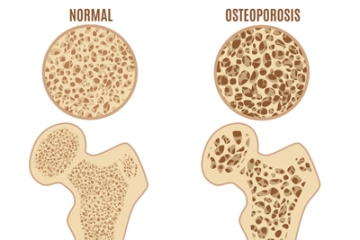
What is Osteoporosis?
Osteoporosis is a condition that weakens bones, making them fragile and more likely to break. It occurs when bone density decreases, and the body loses more bone than it creates. This condition is often called the “silent disease” because it progresses without symptoms until a fracture occurs, typically in the hip, spine, or wrist.
Who is Affected by Osteoporosis?
Osteoporosis primarily affects older adults, particularly postmenopausal women due to a decline in estrogen levels. However, men can also develop osteoporosis, especially after the age of 70. Other risk factors include certain medical conditions, medications, and lifestyle choices.


Symptoms of Osteoporosis:
Osteoporosis often has no symptoms until a bone fracture occurs, but warning signs can include:
1) Back pain caused by a fractured or collapsed vertebra.
2) Loss of height over time.
3) A stooped posture (kyphosis).
4) Bones that break easily, even with minor falls or injuries.
How is Osteoporosis Treated and Managed?

Treatment Options for Osteoporosis:
Treatment focuses on strengthening bones, preventing fractures, and slowing the progression of bone loss:
1) Medications:
• Bisphosphonates: Alendronate, risedronate, and zoledronic acid reduce bone loss.
• Denosumab: A monoclonal antibody to prevent bone breakdown.
• Hormone therapy: Estrogen therapy for postmenopausal women.
• Selective Estrogen Receptor Modulators (SERMs): Raloxifene helps maintain bone density.
• Teriparatide or Romosozumab: Stimulates new bone growth in severe cases.
2) Calcium and Vitamin D Supplements:
• Adequate calcium and vitamin D intake is essential for bone health.
3) Physical Therapy and Exercise:
• Weight-bearing and muscle-strengthening exercises to maintain bone density and balance.
4) Fall Prevention:
• Modifications in the home environment and assistive devices to reduce the risk of falls.
Self-Help Measures:
• Diet: Include calcium-rich foods (dairy, green leafy vegetables, fortified foods) and vitamin D sources (fatty fish, fortified milk, sunlight).
• Exercise: Regular weight-bearing and strength-training exercises.
• Quit Smoking: Smoking weakens bones and interferes with calcium absorption.
• Limit Alcohol: Excessive alcohol consumption increases fracture risk.
• Fall Prevention: Keep rooms well-lit, secure rugs, and use non-slip mats.


What is the Outlook for Osteoporosis?
Osteoporosis is a manageable condition with early detection and proper treatment. By taking steps to strengthen bones, prevent fractures, and lead a healthy lifestyle, individuals with osteoporosis can maintain mobility and independence. Regular monitoring and follow-up with a healthcare provider are essential to assess bone health and adjust treatment as needed.
